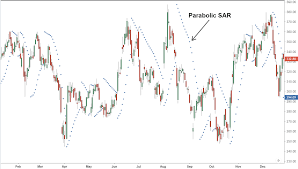Table of Contents
ToggleParabolic SAR: Riding the Trends with Precision
In the ever-evolving landscape of technical analysis, traders rely on a multitude of indicators to make sense of market movements and identify profitable opportunities. Among these tools, the Parabolic SAR (Stop and Reverse) stands out as a versatile and effective indicator for trend following and reversal strategies. In this article, we’ll explore what the Parabolic SAR is, how it works, and how traders can utilize it to enhance their trading strategies.
Understanding Parabolic SAR
Developed by J. Welles Wilder Jr., the Parabolic SAR is a trend-following indicator designed to identify potential reversal points in the price of an asset. It is represented by a series of dots that appear either above or below the price chart, indicating potential stop and reversal points.
How Parabolic SAR Works
The Parabolic SAR is calculated based on the following formula:
𝑆𝐴𝑅𝑛=𝑆𝐴𝑅𝑛−1+𝐴𝐹×(𝐸𝑃𝑛−1−𝑆𝐴𝑅𝑛−1)SARn=SARn−1+AF×(EPn−1−SARn−1)
Where:
- 𝑆𝐴𝑅𝑛SARn is the SAR for the current period.
- 𝑆𝐴𝑅𝑛−1SARn−1 is the SAR for the previous period.
- 𝐴𝐹AF is the acceleration factor, which starts at a value of 0.02 and increases by 0.02 each time the extreme point (EP) reaches a new high or low.
- 𝐸𝑃𝑛−1EPn−1 is the highest high or lowest low of the previous period.
Using Parabolic SAR in Trading
Traders employ Parabolic SAR in various ways to make trading decisions:
- Trend Following: When the Parabolic SAR dots are below the price, it indicates an uptrend, and traders may consider buying. Conversely, when the dots are above the price, it indicates a downtrend, and traders may consider selling short.
- Stop Loss Placement: Traders use Parabolic SAR as a trailing stop-loss mechanism. As the price moves in their favor, they adjust their stop-loss orders to follow the SAR dots, locking in profits and minimizing potential losses.
- Reversal Signals: When the direction of the SAR dots changes, it may signal a potential trend reversal. Traders look for confirmation from other indicators or price action before entering a trade in the opposite direction.
Considerations when Using Parabolic SAR
- Whipsaws: Parabolic SAR can produce whipsaws in ranging markets, where it generates multiple signals but fails to capture sustained trends. Traders should use it in conjunction with other indicators to filter out false signals.
- Acceleration Factor: The acceleration factor determines how quickly the SAR moves closer to the price. Traders may adjust the acceleration factor to suit the volatility of the asset being traded.
- Confirmation: Always confirm Parabolic SAR signals with other technical indicators or price action to increase the accuracy of trading decisions.
Conclusion
The Parabolic SAR is a valuable tool for traders seeking to ride trends with precision and manage risk effectively. By understanding its mechanics and incorporating it into their trading strategies, traders can gain valuable insights into market trends and identify profitable trading opportunities. However, like any indicator, Parabolic SAR is not without limitations and should be used in conjunction with other tools and proper risk management techniques. With its ability to identify trend direction and potential reversal points, Parabolic SAR remains a cornerstone of technical analysis for traders across various financial markets.
